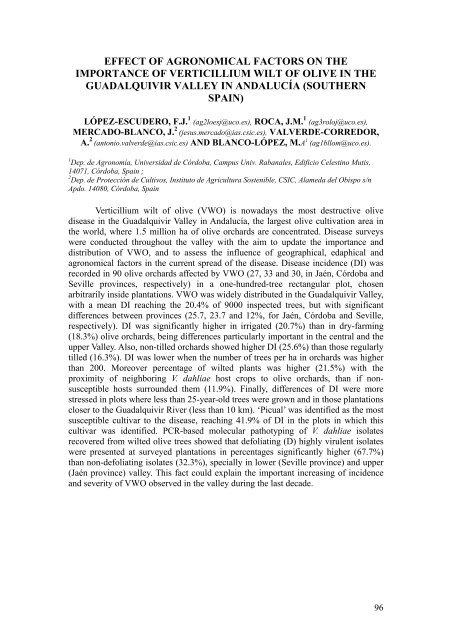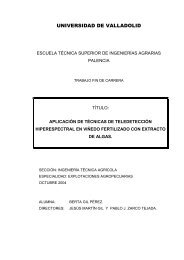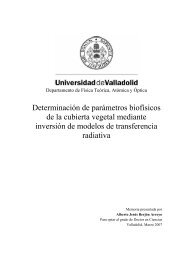10th INTERNATIONAL VERTICILLIUM SYMPOSIUM 16-20 ...
10th INTERNATIONAL VERTICILLIUM SYMPOSIUM 16-20 ...
10th INTERNATIONAL VERTICILLIUM SYMPOSIUM 16-20 ...
You also want an ePaper? Increase the reach of your titles
YUMPU automatically turns print PDFs into web optimized ePapers that Google loves.
EFFECT OF AGRONOMICAL FACTORS ON THEIMPORTANCE OF <strong>VERTICILLIUM</strong> WILT OF OLIVE IN THEGUADALQUIVIR VALLEY IN ANDALUCÍA (SOUTHERNSPAIN)LÓPEZ-ESCUDERO, F.J. 1 (ag2loesj@uco.es), ROCA, J.M. 1 (ag3roloj@uco.es),MERCADO-BLANCO, J. 2 (jesus.mercado@ias.csic.es), VALVERDE-CORREDOR,A. 2 (antonio.valverde@ias.csic.es) AND BLANCO-LÓPEZ, M.A 1 (ag1bllom@uco.es).1 Dep. de Agronomía, Universidad de Córdoba, Campus Univ. Rabanales, Edificio Celestino Mutis,14071, Córdoba, Spain ;2 Dep. de Protección de Cultivos, Instituto de Agricultura Sostenible, CSIC, Alameda del Obispo s/nApdo. 14080, Córdoba, SpainVerticillium wilt of olive (VWO) is nowadays the most destructive olivedisease in the Guadalquivir Valley in Andalucía, the largest olive cultivation area inthe world, where 1.5 million ha of olive orchards are concentrated. Disease surveyswere conducted throughout the valley with the aim to update the importance anddistribution of VWO, and to assess the influence of geographical, edaphical andagronomical factors in the current spread of the disease. Disease incidence (DI) wasrecorded in 90 olive orchards affected by VWO (27, 33 and 30, in Jaén, Córdoba andSeville provinces, respectively) in a one-hundred-tree rectangular plot, chosenarbitrarily inside plantations. VWO was widely distributed in the Guadalquivir Valley,with a mean DI reaching the <strong>20</strong>.4% of 9000 inspected trees, but with significantdifferences between provinces (25.7, 23.7 and 12%, for Jaén, Córdoba and Seville,respectively). DI was significantly higher in irrigated (<strong>20</strong>.7%) than in dry-farming(18.3%) olive orchards, being differences particularly important in the central and theupper Valley. Also, non-tilled orchards showed higher DI (25.6%) than those regularlytilled (<strong>16</strong>.3%). DI was lower when the number of trees per ha in orchards was higherthan <strong>20</strong>0. Moreover percentage of wilted plants was higher (21.5%) with theproximity of neighboring V. dahliae host crops to olive orchards, than if nonsusceptiblehosts surrounded them (11.9%). Finally, differences of DI were morestressed in plots where less than 25-year-old trees were grown and in those plantationscloser to the Guadalquivir River (less than 10 km). ‘Picual’ was identified as the mostsusceptible cultivar to the disease, reaching 41.9% of DI in the plots in which thiscultivar was identified. PCR-based molecular pathotyping of V. dahliae isolatesrecovered from wilted olive trees showed that defoliating (D) highly virulent isolateswere presented at surveyed plantations in percentages significantly higher (67.7%)than non-defoliating isolates (32.3%), specially in lower (Seville province) and upper(Jaén province) valley. This fact could explain the important increasing of incidenceand severity of VWO observed in the valley during the last decade.96




